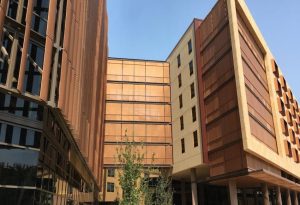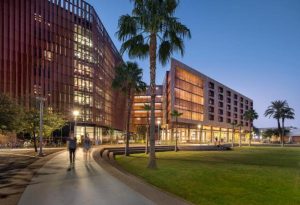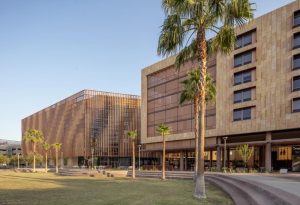Introduction
Tooker House is not just a student residence—it’s a visionary space that redefines the concept of student housing through innovation, sustainability, and academic integration. Located on the Arizona State University (ASU) Tempe campus, Tooker House is a state-of-the-art, co-ed residential community designed specifically for students in the Ira A. Fulton Schools of Engineering. Opened in 2017, this cutting-edge facility combines high-tech amenities with community-building features, aiming to foster both academic success and social connection.
This article explores the design, features, and cultural impact of Tooker House, highlighting why it’s considered one of the most advanced student housing facilities in the United States.
History and Purpose
Named after ASU alumni Diane and Gary Tooker, Tooker House was established through a generous $10 million donation to support the university’s engineering program. Gary Tooker, a former CEO of Motorola, is a strong advocate for STEM education and innovation. The residence was built with the intent to provide engineering students with a unique living-learning environment that supports academic excellence, creativity, and real-world problem-solving.
Construction began in 2016 and the building officially opened its doors in fall 2017. Since then, Tooker House has housed thousands of engineering students and has played a significant role in defining a new standard for on-campus living.

Architectural Innovation and Design
Tooker House is a shining example of how architectural design can serve both function and inspiration. The 7-story, 252,000-square-foot building was designed by renowned architecture firm SCB (Solomon Cordwell Buenz) in collaboration with Sundt Construction, incorporating sustainable materials and energy-efficient systems throughout.
Key architectural features include:
-
Energy-efficient windows and walls for passive solar shading
-
Smart thermostats and lighting to conserve energy
-
Gender-inclusive design with co-ed floors and bathrooms
-
Natural lighting and ventilation for improved indoor air quality
Each room is designed with comfort and usability in mind, including modern furnishings, high-speed internet, and technology-ready setups that align with the needs of engineering students.
Smart Technology and Sustainability
One of the most defining features of Tooker House is its integration of smart technology and sustainability. ASU’s commitment to reducing its carbon footprint is reflected in the design and function of this residence.
Tech-forward sustainability features include:
-
Smart thermostats that learn student preferences and adjust accordingly
-
Energy dashboards on each floor that monitor and display real-time energy use
-
LED lighting and occupancy sensors in hallways and common areas
-
Low-flow water fixtures and water bottle refill stations
Tooker House earned a LEED certification (Leadership in Energy and Environmental Design), reinforcing its role as a model for sustainable student living.
Living-Learning Environment
Tooker House isn’t just about providing a place to sleep; it’s about nurturing a lifestyle that supports learning and collaboration. The residence is tailored specifically for students in engineering disciplines, allowing them to live alongside peers who share similar academic paths.
Features that support this mission include:
-
Collaborative makerspaces with 3D printers, laser cutters, and engineering tools
-
Computer labs and study lounges on every floor
-
Tutoring centers and academic advising offices within the building
-
Seminar and meeting rooms for group projects and presentations
This immersive environment encourages the blending of residential life with academic ambition, helping students stay engaged and motivated in their studies.
Student Life and Community Engagement
Tooker House is home to more than 1,500 students, creating a vibrant and diverse community. Student life here is supported by a range of programming and resources that help build friendships, promote wellness, and strengthen connections.
Highlights of student life at Tooker House:
-
Events and social gatherings, including game nights, guest lectures, and movie screenings
-
Residential Community Assistants (RCAs) who support students and organize community programs
-
Living-learning communities (LLCs) focused on shared academic or personal interests
-
Fitness rooms, outdoor seating areas, and green spaces for recreation and relaxation
This environment fosters an inclusive and energetic culture where students can grow both academically and personally.
Dining and Amenities
Attached to Tooker House is a full-service dining hall that offers a wide range of healthy and diverse meal options. The dining facility is open to all ASU students but is especially convenient for Tooker residents.
Additional amenities include:
-
Laundry facilities on-site with smartphone-integrated monitoring
-
Secure bike storage
-
24-hour front desk security
-
Mail and package delivery services
-
Proximity to campus resources, including engineering buildings, libraries, and transportation hubs
The convenience of these amenities allows students to focus more on their studies and less on daily logistical concerns.

Impact on Engineering Education
Tooker House plays a significant role in the academic journey of many ASU engineering students. The close proximity to labs, faculty offices, and classrooms enables seamless access to academic support. More importantly, the community within the residence fosters peer learning and innovation.
Students often report feeling more connected to their coursework and inspired to pursue collaborative projects because of the shared energy within Tooker House. The integration of real-world engineering tools and spaces encourages students to experiment and develop solutions to real-world problems—before they even graduate.
Recognition and Influence
Since its opening, Tooker House has received national attention for its innovative design and educational value. It has been featured in architectural and higher education journals and has become a model for other universities aiming to enhance on-campus residential life through smart, sustainable design.
In 2018, Tooker House won the Best On-Campus Housing Project award from the Student Housing Business Innovator Awards, validating its unique approach to combining high-tech facilities with student-focused living.
Conclusion
Tooker House at Arizona State University stands as a bold example of what modern student housing can and should be. By blending technology, sustainability, and a focus on academic integration, it creates an environment where engineering students can truly thrive.
More than a residence hall, Tooker House is a launching pad for the next generation of innovators, problem-solvers, and community leaders. As universities across the country look to enhance the student experience, Tooker House offers a powerful blueprint for the future of campus living.

Frequently Asked Questions (FAQ)
Q1: What is Tooker House at ASU?
A1: Tooker House is a state-of-the-art residential facility at Arizona State University designed for engineering students, combining modern amenities with academic resources.
Q2: Who can live in Tooker House?
A2: Primarily first-year students enrolled in the Ira A. Fulton Schools of Engineering are eligible to live in Tooker House.
Q3: What amenities does Tooker House offer?
A3: Amenities include tech-enabled study rooms, makerspaces, smart thermostats, fitness areas, laundry rooms, dining facilities, and academic support centers.
Q4: Is Tooker House sustainable?
A4: Yes, Tooker House features energy-efficient systems, water-saving fixtures, and has earned LEED certification for sustainability.
Q5: What makes Tooker House unique?
A5: Its integration of smart technology, engineering-focused design, and living-learning community structure make it one of the most innovative student residences in the country.



